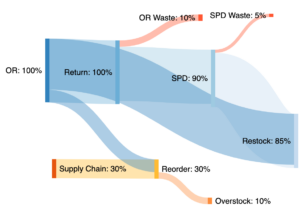The Cost of Unused Surgical Supplies

Do you know the true cost of your unused surgical supplies? If you have worked in the operating room (OR) for any length of time, then you know the frustration of managing excess supplies. The pain is real, and the pain is widely felt. Nevertheless, most hospital administrators do not have a detailed or complete view of the cost associated with their unused supplies.
Medical Supply Waste
There are several reasons why unused supplies tend to have a negative effect on your surgical services department. First, the delivery of unnecessary supplies to the operating room results in a huge amount of supply waste. If you are regularly picking items in the supply room, placing them on case carts, bringing them into the OR suite, placing them back on case carts, and then transferring them back to the supply room, then you are over-handling your supplies. When you touch your supplies over and over, you increase the likelihood of compromising the sterile integrity of your supply packages. Our research suggests that US hospitals collectively waste nearly $45 billion each year in disposable surgical supplies. In a world of supply shortages and backorders, this number is simply unacceptable.
Misuse of Staffing Resources
Second, the delivery of unnecessary supplies to the operating room places a significant strain on hospital staffing resources. During my two years as PrefTech’s VP of Client Success, I have had the opportunity to interview numerous hospital clients as they begin PrefTech’s platform implementation process. Every single hospital has reported that supply “return” activity (that is, the effort to re-deliver supplies from the OR back to the supply room) is completely overwhelming their supply chain and sterile processing departments. Some hospitals have said that they see forty percent or more of their picked supplies being returned to the supply room every day. What an exhausting misuse of labor! Hospitals face innumerable stressors and can ill afford the dissipation of staffing resources. The time that employees spend managing returned supplies could be better spent cleaning and sterilizing critical instrument sets that must be readied to support the following day's surgical cases.
Inaccurate Inventory Data
Third, the habit of delivering excessive supplies to your operating room will likely distort perceptions regarding your inventory and thus cause a “bullwhip” or “whiplash” effect on your supply chain. If supplies are needlessly circulating your hospital, then it is difficult to monitor your actual inventory levels—and if you have poor information regarding your inventory levels, then you are very likely to over-order or under-order supplies on a regular basis. Unused supplies that are sitting on cases carts are likely to be re-ordered unnecessarily. When members of the supply chain team check inventory levels, it will erroneously appear that supplies have been consumed and that a new purchase order needs to be made. When the ordered supplies come in and are placed back on the shelf, frustrated staff will realize that there was no immediate need to re-order. Poor supply data encourages poor purchasing decisions.
Imagine what life would be like if you could cut your returned surgical supplies in half. At first blush, this may sound like an impossible task—but it’s not. Not only is it possible to dramatically reduce your unused and returned supplies, it is actually quite simple to accomplish. With the use of PrefTech’s revolutionary artificial intelligence engine, you can establish control over inventory and optimize the delivery of supplies to your operating rooms. PrefTech customers regularly report seeing their returns drop in half . . . after using the PrefTech OR platform for less than a year! If you would like to see how you can leverage PrefTech to achieve similar results, do not hesitate to reach out to our team. We are eager to help you to drive dramatic OR cost reductions.




